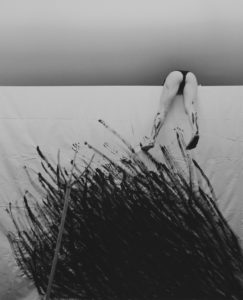The black-and-white photographs of Carina Brandes, which capture her ritualistically enigmatic performances for a self-timed camera, suffer a paradoxical fate: they’re modestly powerful images grounded in a uniquely European sensibility, but ultimately leave little impression. One wishes they would. Her investment in these quasi-performances promotes a sympathetic viewing, allowing ample benefit of the doubt.
Brandes, who is based mainly in Berlin, takes her equipment, a few props and substantial quantities of black body paint (and occasionally a collaborator when shooting on a set), ventures forth into a landscape, and shoots herself in ambiguous, vaguely tribal acts. One senses that Brandes has willed herself into a trance-based frenzy and conjured up a spirited version of herself. Of the approximately 10 images, the most iconic is the shot of the artist as seen through a star-shaped cutout. Her naked body, face and hair painted black, she hovers mid-jump, her outstretched legs well-aligned into the silhouette of the lower two star points, her outstretched arms cut off at the shoulders by the top star point, the spare background desert-like. It’s a beautiful composition—and, again, an iconic image—and yet if just one accoutrement were added, it’s not hard to imagine it re-contextualized in a fashion magazine. That’s not an indictment—many fashion ads are quite avant-garde, albeit enslaved to that context.

Carina Brandes, Untitled 162, 2014; ©Carina Brandes, courtesy of the artist and team (gallery, inc.), NY, LA
Another work, if not the most iconic then the most memorable of the bunch, has the artist behind a painted black “curtain,” her parted hair hanging over its front, her right eye peering at us from behind her hair, hands spread, perched noncommittally over the curtain’s edge; a large image of Bugs Bunny’s head in full grin looms just to her right (presumably painted onto the wall behind, though it’s not clear), his slightly blurred appearance enhanced by the grainy matte print. Here, our cultural inheritance, whether high art or pop-cultural, dictates that we run with ominous potentialities—not necessarily being raped, literally or figuratively, by the cartoon icon, though the thought inevitably occurs. There’s clearly an authentic bizarreness, a creepiness that Brandes has achieved; however, we’re not 100% sold—almost as if the “creepiness” were in quotes.
The master of the bizarre and enigmatic, the late great wunderkind Francesca Woodman—also her own best model—comes to mind. Is Woodman’s work more successful because there was more at stake? That’s a long answer; the short one is that Woodman and Brandes made/make work in very different contexts, with very different expectations. It’s actually Brandes’ late countryman Josef Beuys whose affinity is more apt (indeed, the cover of a 2011–2013 catalog features Brandes bent at the waist, wearing a leopard-print coat and a bear’s head). But whereas Beuys had his war experiences as inspiration, Brandes’ concerns come out of more nebulous sources, a mixture of intellectual discourse, the history of photography, and performance. And one can analyze the work from that angle if one chooses to. What her works do offer, without question, is mystery, ambition and an uncompromised vision, but, alas, it’s not enough to transcend the contemporary art fray.


